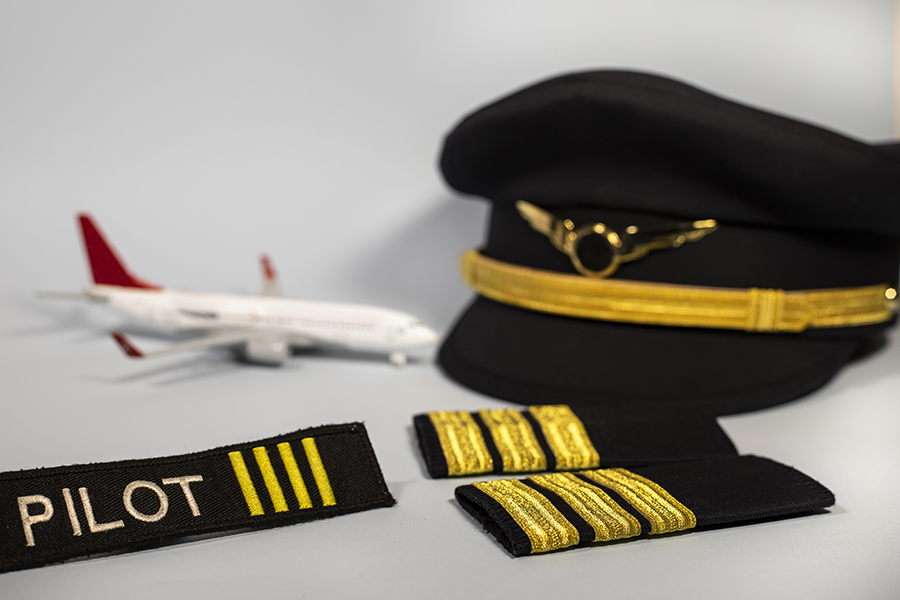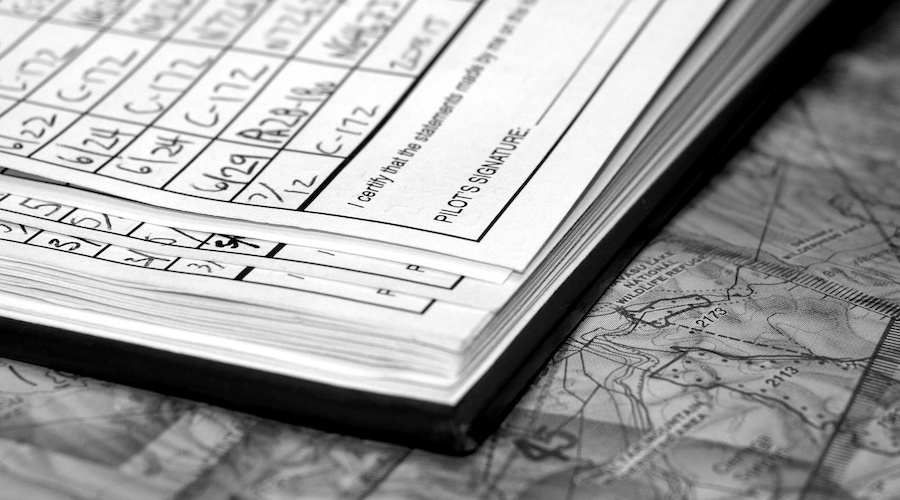Exciting news: Pilot Institute is now FAA-Approved for Part 65 Dispatcher Training!
In just 8 weeks you can become an FAA-Certified Aircraft Dispatcher and start building your career path toward $55K+ roles with Delta, United, American & more – no expensive degree required.
- We’ve trained 400,000+ aviation professionals, with a 99.8% first-time pass rate and exam scores 10% above the national average.
- And under the guidance of Justin McKelvey (FAA-Certified Dispatcher, commercial pilot, and former university professor) you’ll gain the real-world skills airlines pay for.
- Every month you wait is another hiring wave you miss (our next class starts months from now).
Only 5 slots remain per cohort – secure your spot with $799 down.
Click here to lock in your seat and start the career you’ve been dreaming of.
Aircraft dispatchers hold some of the most important roles in aviation. If you want to join this extraordinary club, there are a few steps you’ll need to follow to prepare yourself for the job.
Think you’ve got what it takes? Let’s chart your course and help you land that position.
Key Takeaways
- An aircraft dispatcher coordinates flights, ensuring safety and efficiency from the ground. This includes checking the weather, creating flight plans, and communicating with pilots.
- Ensure you meet the FAA’s requirements for an Aircraft Dispatcher Certificate.
- Choose an FAA-accredited training program that fits your schedule, budget, and location.
- Passing the FAA knowledge and practical tests is essential. It assesses your understanding of regulations, weather, navigation, and decision-making.
- The demand for flight dispatchers is stable, with about 1,000 job openings annually. You’ll be in for a promising career if you’re committed and prepared.
What Does an Aircraft Dispatcher Do?
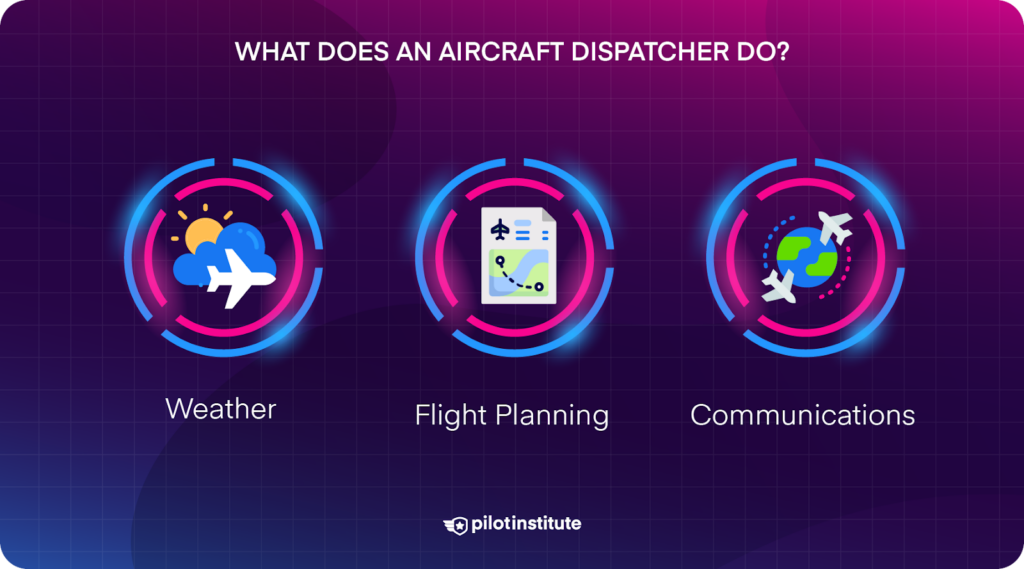
Firstly, you’ll need to understand what the job entails. So, what does an aircraft dispatcher do, exactly?
Aircraft dispatchers work for passenger and cargo air carriers. They coordinate day-to-day flight operations from the ground, ensuring safe and efficient turnaround.
A flight dispatcher’s day begins with checking the weather. They check for weather and visibility information about the areas covered for the day’s flights. The METAR and TAF are fundamental tools in their workday. Dispatchers make forecasts and decisions before the aircraft even gets off the ground!
Aircraft dispatchers are also responsible for issuing flight plans. Even with advanced software, several factors can affect portions of a flight. This is where aircraft dispatchers come in.
Dispatchers relay navigation information and flight plan guidelines to pilots. They inform pilots about any sudden hazards or changes in their flights.
Eligibility

Before anything else, you should ensure you’re eligible for an Aircraft Dispatcher Certificate. The FAA requires that you must:
- Be at least 23 years old.
- Have a high school diploma or equivalency.
- Be able to speak English.
- Undergo 200 hours of training with an FAA-approved program.
- Pass the FAA Aircraft Dispatcher Knowledge Test and Practical Test.
Education
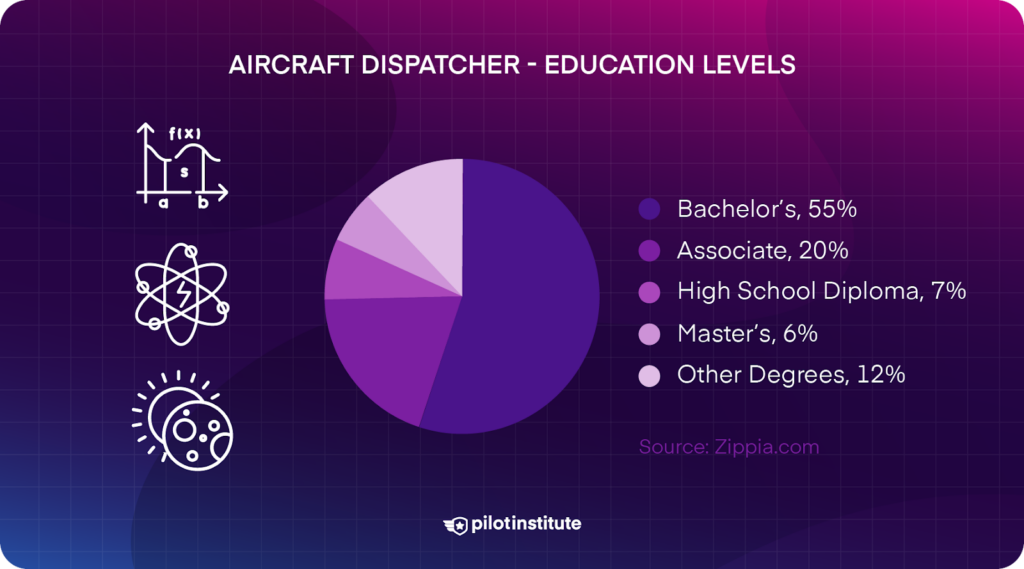
For aircraft dispatch positions, a college degree is preferred but not required. However, over 75% of all aircraft dispatchers have some post-secondary degree. If you want to gain an edge over the competition, you will need an associate’s or bachelor’s degree.
So, which major should you choose? No specific area of study is required. However, employers prefer these three courses: mathematics, physics, and meteorology.
Master the key concepts in these areas, and you’ll thank yourself once you enter dispatch school. You’ll be set for success, and you won’t start from zero knowledge later on. A degree will also expand your possibilities. It will provide you with more career options and security.
College also teaches you skills that shape you into an excellent flight dispatcher. Strong communication skills, ability to work under pressure, and attention to detail are vital in the work environment.
Some colleges offer specialized programs that lead to certification. There are also those that offer training as a component of an associate’s or bachelor’s degree. Consider those options if you want to kill two birds with one stone!
Aircraft Dispatcher Training

After college, your next step will be to enter a flight dispatch school. This is where you will undergo the standard 200 hours of training required to earn your FAA Aircraft Dispatcher (ADX) Certificate.
Your training will cover a wide range of topics, such as:
- U.S. regulations and laws
- Meteorology
- Weather interpretation
- Principles of Air Navigation
- Air traffic control procedures
- Aircraft loading, weight, and balance
- Decision-making and judgment
- Crew communication and coordination
There are plenty of schools that offer aircraft dispatcher programs. How can you choose which one is right for you?
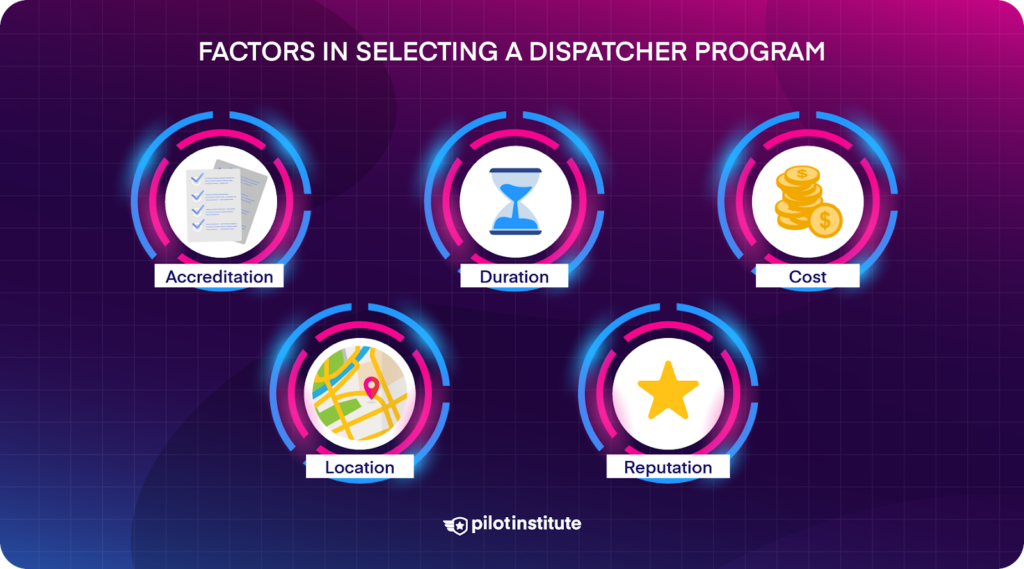
Well, it all boils down to these factors:
- Accreditation. First and most importantly, the program must be accredited by the FAA. This ensures that the curriculum meets the required standards. This is also crucial for your eligibility to take the knowledge test. The FAA has published a list of accredited programs, which you can check out here.
- Duration. Training programs can last anywhere from 5 weeks to 6 months. This will depend on whether you enroll full-time or part-time.
Full-time programs are more intensive and allow you to complete your training faster. Part-time programs offer you more flexibility and freedom if you have other commitments.
Whichever works best for you will ultimately depend on your schedule and availability.
- Cost. Aircraft dispatcher training typically costs between $3,000 and $8,000. This will depend on factors like program length and location.
The good news is that some programs offer financial aid options. You can apply for scholarships or payment plans to make the training more affordable.
Take a look at your budget, and consider the value and return on investment when choosing a program.
- Location. Most programs require in-person attendance for more hands-on experience. On the other hand, online programs give you the flexibility to study from anywhere.
Your choice should depend on your learning style, personal commitments, and geographical location. Hybrid options also exist. These combine online coursework with occasional in-person sessions, offering a balanced approach.
- Reputation. The training program’s reputation is essential. It ensures a quality education and better career opportunities. Research reviews and testimonials from past students to understand the program’s strengths. Also, look into how well it prepares students for FAA exams and the level of support provided.
If a school claims to have a 100% pass rate, you should question how high their standards are. A well-regarded program can enhance your prospects and guarantee a high training standard.
Getting Your FAA ADX Certificate
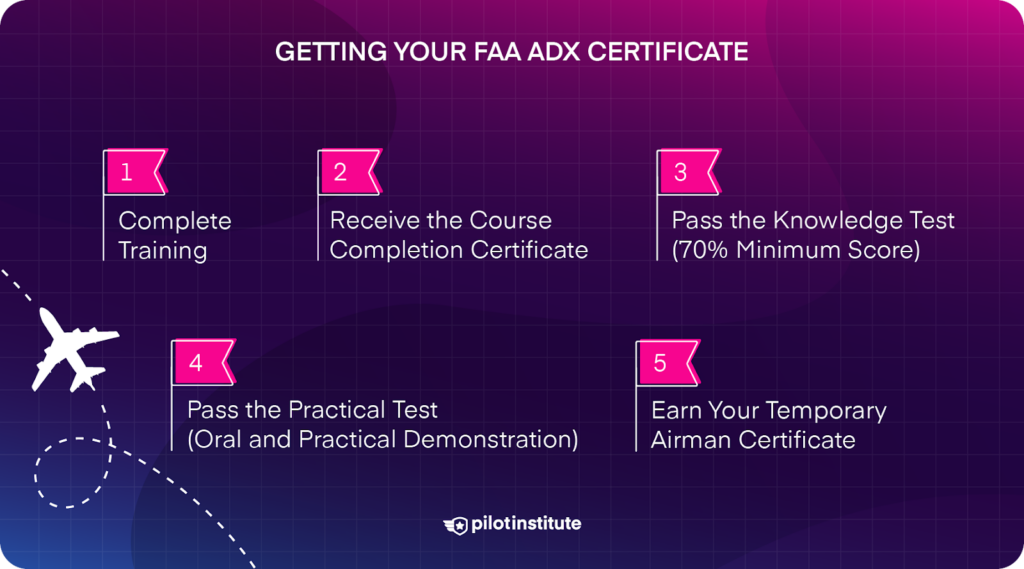
After you finish your training, you will take the FAA tests to earn your certificate. These are the knowledge test and the practical test.
Knowledge Test
The FAA Aircraft Dispatcher Knowledge Test is a critical step in becoming an aircraft dispatcher. It will assess your understanding of the concepts you studied in your training.
You can schedule your FAA ADX Knowledge Test through an approved testing center. To register, sign up on IARCA and get your FAA tracking number (FTN). Once you get your FTN, visit the PSI website and create an account. Provide your course completion certificate and select a convenient testing location. The test fee is typically around $175.
What can you expect on the knowledge test?
The test is computer-based and consists of multiple-choice questions. They’re designed to test your theoretical knowledge and practical skills in flight dispatch.
The test typically consists of 80 multiple-choice questions. You’ll have 3 hours to complete the test. Each question has three possible answers, with only one correct choice.
There are three kinds of questions that you should expect to come up:
- Direct Knowledge. These questions test your understanding of specific facts, such as regulations or definitions.
- Application. These are scenarios where you apply knowledge to real-world situations, such as interpreting weather data or making flight planning decisions.
- Critical Thinking. These questions require you to analyze and evaluate information to make a decision, such as determining the safest route or managing an in-flight emergency.
The minimum passing score is 70%. This means you need to answer at least 56 out of 80 questions correctly.
Your test will be scored upon completion, and you’ll receive your results right away.
Practical Test
Passing the knowledge test is just one part of the certification process. After passing, your next step will be to prepare for the practical test.
The test will evaluate your knowledge and skills applied to real-world scenarios.
You can schedule your practical test with an FAA Designated Aircraft Dispatcher Examiner (DADE). Use the FAA’s Designee Locator tool to search for a DADE in your area. Your dispatch school can also recommend a DADE or help arrange the practical test. The test fee can range from around $300 to $600.
The test typically lasts 4 to 8 hours, depending on the given scenarios and your pace.
The test is divided into two parts: an oral examination and a practical demonstration.
The oral exam is a one-on-one interactive discussion with the DADE or FAA inspector. You’ll be asked questions and expected to explain concepts related to flight dispatching.
The practical part involves applying your knowledge to real-world scenarios. The examiner will present you with a series of flight dispatch scenarios. You’ll have to manage these scenarios from start to finish.
The examiner will evaluate you based on the following criteria:
- Knowledge: your understanding of FAA regulations, weather interpretation, aircraft performance, and flight planning.
- Application: how well you apply theoretical knowledge to practical situations. For example, managing flights and responding to emergencies.
- Decision-Making: your ability to make sound, timely decisions in changing conditions.
- Communication: effective communication with the examiner (acting as the pilot or other stakeholders). You’ll need to explain your thought process clearly and concisely.
If you pass, you’ll receive a Temporary Airman Certificate. This will allow you to work as a dispatcher until your permanent certificate arrives.
Earning your FAA Aircraft Dispatcher Certificate is no small feat. Reaching this step deserves to be celebrated!
But as a rookie trying to make it in the industry, how can you measure up to the competition?
Gaining Relevant Experience
Employers often look for candidates who have experience under their belt. This will help you master the job and make your resume stand out.

Gain experience through internships or entry-level positions. Many airlines and aviation companies offer internships specifically designed for newly certified dispatchers.
As an intern, you’ll work under the supervision of experienced dispatchers. You will learn to handle day-to-day operations, communicate with pilots, and manage unexpected situations.
You can also apply for entry-level positions like dispatch assistant or coordinator. In these roles, you will be supporting the main dispatch team. Your tasks will include data entry, monitoring flight operations, and preparing reports. As you prove your capabilities, you’ll be given more responsibilities. Eventually, you can move into a full dispatcher role.
Not only will you learn from this, but you’ll also get the opportunity to build your network. The aviation industry is relatively tight-knit. Building connections with professionals in the field can definitely boost your career prospects.
Attend industry events, such as aviation conferences and job fairs. These are where you can meet potential employers and learn about job opportunities. Joining professional organizations like the Airline Dispatchers Federation (ADF) also provides networking opportunities. You’ll gain access to resources like job boards, industry news, and continuing education.
You can also further your education in specialized areas of aircraft dispatching. Check out certifications in international flight planning or hazardous materials handling. Additional training helps you improve specific skills and gives you something to add to your resume.
These additional qualifications can make you more attractive to employers. You’ll definitely stand out to those who handle international flights or special cargo.
Specialized training can also open up opportunities for advancement within your organization. You can get the chance to move into supervisory or management roles.
Applying for Jobs
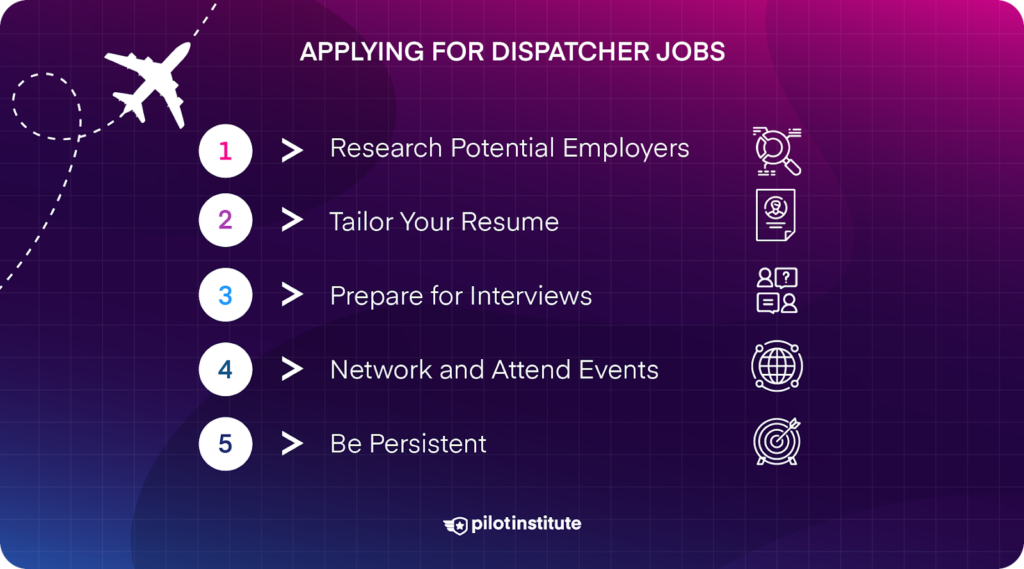
Once you’ve gained some experience, it’s time to start applying for jobs!
Securing an aircraft dispatcher position can be competitive. Therefore, it’s essential to be strategic with this process.
So what’s the best path to take?
Begin by researching potential employers. Your options can include:
- Commercial airlines
- Cargo carriers
- Corporate flight departments
- The FAA
- The National Transportation Safety Board (NTSB)
Plenty of aircraft dispatchers started out in a Part 91 operation and eventually worked their way up to Part 135 and then Part 121. You can learn more about these categories in this article.
Tailor your resume to display your training, certification, and any relevant experience. Highlight any hands-on experience during internships, entry-level positions, or other relevant roles.
Hiring managers may be using applicant tracking systems to screen resumes. To make your resume stand out, use industry-specific keywords and phrases.
A well-crafted cover letter also makes a significant difference in your job application. Use the cover letter to express your passion for aviation and your commitment to safety. Explain how your training and experience have prepared you for the role’s challenges. Also, mention why you’re interested in working for the company you’re applying for.
Preparing for interviews is another crucial aspect of the job application process. Employers will assess your knowledge of regulations and flight planning. They’ll also evaluate your ability to handle various flight scenarios.
Practice answering common interview questions. You may be asked about real-life scenarios. Expect to be asked how you would respond to a sudden change in weather or manage a flight delay. Show your problem-solving abilities and your understanding of the dispatcher’s role. But most importantly, be yourself!
As you apply for jobs, you’ll have to be flexible and open to opportunities that may need relocation. The demand for aircraft dispatchers can vary by region. Being willing to move to a different city or state can increase your chances of securing a position. Regions with a high concentration of aviation companies may have more job opportunities.
Don’t be discouraged if you don’t land your dream job right away. The aviation industry is highly dynamic, and persistence is key.
Continue networking, attending industry events, and staying informed about job openings. Even if you don’t start in your ideal role, gaining experience can lead to opportunities down the road. As you build your reputation and expertise, you can move into better positions!
Current Job Market

With the current job market, how good are your chances of landing a job?
The demand for flight dispatchers in the U.S. is showing clear signs of growth. This increase in openings is driven by the industry’s ongoing recovery and expansion.
For instance, United Airlines is expected to make large hiring efforts. They aim to break records by 2024 with plans to expand their workforce. This includes a wide range of roles, including flight dispatchers.
The U.S. Bureau of Labor Statistics projects a stable demand for flight dispatchers. These job openings are driven by retirements and the need to replace vacancies. On average, there are about 1,000 job openings for flight dispatchers annually. This number includes both new positions and replacement roles.
Job boards also show multiple airlines actively recruiting dispatchers. Make a quick search, and you’ll find dozens of job postings across many employers. The demand for these roles is consistent. This shows the aviation industry’s need for qualified staff.
These figures show a strong demand for flight dispatchers. You’re in luck because now is the perfect time to enter the field!
Conclusion
There’s a reason why aircraft dispatchers are called the unsung heroes of the sky. They work in the background. They ensure flights run safely, even when their contributions are hardly recognized.
Becoming a flight dispatcher requires dedication, but the rewards are worth it. With training and experience, you’ll be well-prepared for this crucial role.
How well can you calculate weight and balance? It’s an essential part of the job, so you better brush up if you’re rusty. Check out this article for a good refresher on the procedure.
Stay committed and keep learning. You’ll be on your way to a fulfilling aircraft dispatcher career!

